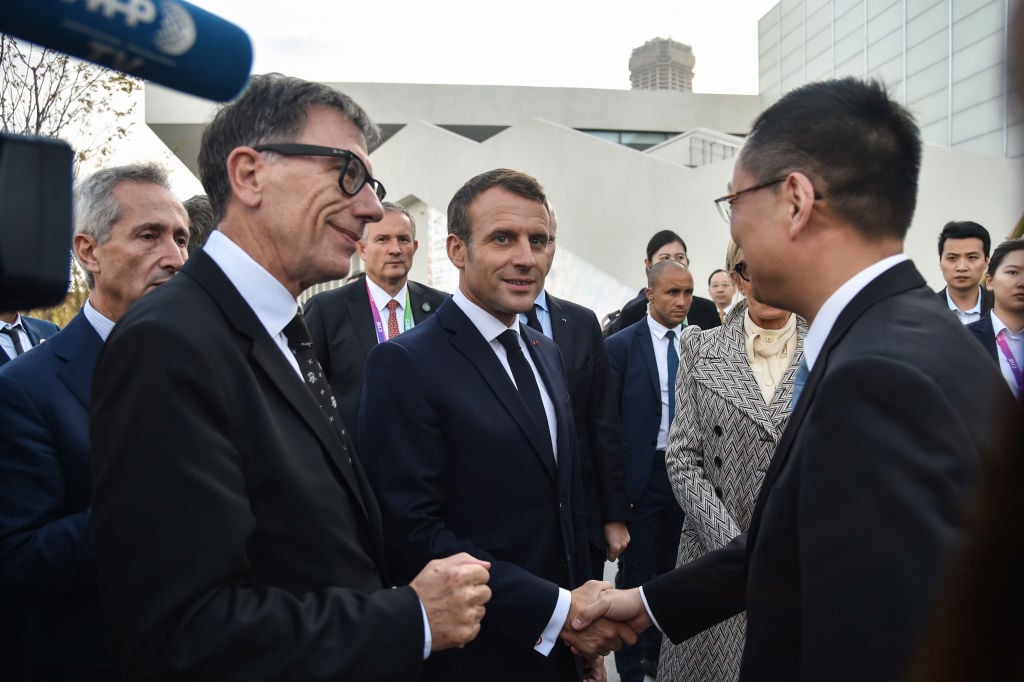
The French President Emmanuel Macron is in Shanghai this week for the opening of the Centre Pompidou’s first venue in China. The joint venture with the city’s developing West Bund district means that the Paris institution finally gains a foothold in the country, and France can flex more of its soft power in Asia. But the deal comes with strings attached: All the art on show has to be “pre-approved” by the Chinese authorities.
Called the Centre Pompidou x West Bund Museum Project, the waterfront institution opens to the public on Friday, November 8, against a backdrop of pro-democracy demonstrations in Hong Kong, and a simmering trade war between the US and China. The main reason for Macron’s second state visit to China in two years is to discuss trade and climate with Chinese President Xi Jinping. At the inauguration of the Pompidou, Macron celebrated the opening after taking a tour of the museum: “Long live the friendship of China and France.”
The Centre Pompidou has been one of France’s most entrepreneurial art institutions, sending loan shows across the globe. It has been seeking a Chinese outpost for at least a decade. In 2015, it opened a franchised space in Malága in Spain, and another is planned in Brussels for 2023. But a Pompidou in Shanghai raises the stakes of its brand expansion and the new franchise in China by a European museum has inevitably raised a few eyebrows, particularly considering China’s tightening censorship of art with political messages, however indirect.
The president of the Pompidou, Serge Lavignes, said in a statement that the new institution will have “sufficient freedom” to work in China, although he has admitted that a handful of works destined for the inaugural show were “edited” at the request of the authorities for “various” reasons.
West Bund Art Museum, Shanghai. Rendering © David Chipperfield Architects.
Museum Mile
The Shanghai satellite of Paris’s Modern and contemporary art museum is housed in a massive venue designed by the British architect David Chipperfield. The opalescent glass building is the latest addition to the city’s West Bund “museum mile” on the banks of the Huangpu River. The project is a partnership with the West Bund Group, a Chinese state-owned development corporation.
In total, the West Bund Group has invested $3 billion into creating a cultural art hub at the new waterfront area, which includes a new park. The former industrial district on the city’s waterfront is already home to the Long Museum West Bund, the Yuz Museum, and the Shanghai Center of Photography, among other cultural institutions. The new museum’s unveiling coincides with the West Bund Art & Design fair, which opens on November 7 with several Western heavyweight exhibitors, including Sprüth Magers, Gagosian, and Thaddaeus Ropac.
The museum has 27,000-square-feet of exhibition space, and three main galleries. The spaces will host a series of long-term exhibitions over the next five years. Works will be drawn from the Paris museum’s collection. There wil also be two temporary exhibitions each year. A room called “The Box” will host multi-media installations, while “Gallery 0” will host smaller projects by emerging artists.
Lavignes said that one of the goals of the Chinese collaboration is to export France’s “savoir-faire” to help train Chinese museum professionals. He added that the venue also provides the French institution with a “great observation post” to take in Chinese contemporary art. The Pompidou collection currently comprises 200 works by nearly 120 artists who are Chinese or were born in China—a strong number, but one that looks bound to grow. Lavignes said the goal of the West Bund Museum Project includes exploring “non-Western forms of Modernity” at the Pompidou in general. This summer, the Paris museum showed a solo presentation by the Chinese artist Cao Fei.
French President Emmanuel Macron at the inauguration of Centre Pompidou West Bund Museum in Shanghai on November 5, 2019. Photo: Hector Retamal POOL/AFP via Getty Images.
The Trade-Off
While the Pompidou is stressing cultural exchange, the deal is not without its financial benefits. In addition to covering the construction and running costs of the museum, West Bund Group has agreed to also pay the Pompidou around €2.75 million ($3 million) a year, on top of an annual €1.4 million ($1.55 million) for the use of its brand.
There is also the ambition to grow Chinese audiences back in Paris, which the Pompidou hopes will be a side effect of the cross-pollination. Currently, Chinese tourists form only 1 percent of its audience, with the majority heading straight to the Louvre and Musée d’Orsay.
Despite Lavignes’s assurances that the Centre Pompidou’s artistic freedom will not be compromised, already, local officials had requested that a few works in the first show be replaced. Called “The Shape of Things,” the inaugural exhibition includes around 100 works from the Paris museum’s collection, organized by Marcella Lista, the Pompidou’s chief curator of its new media collection. On show are famous paintings, such as Picasso’s The Guitar Player from 1910, alongside works by contemporary Chinese artists like Zhang Huan, as well as world-famous Chinese abstract painter Zao Wou-Ki. Lavignes admitted to the New York Times that there were edits requested by the Chinese authorities of “under five works.” Playing down the issue, he said there were “various” reasons that were “not only political.”
Lavignes touched on the dilemmas involved in working in China in his press statement. He asked: “Ultimately, do we serve democracy better by ignoring China, or by being there, forging ties, providing access to Western culture and talking with partners, artists, and visitors?”